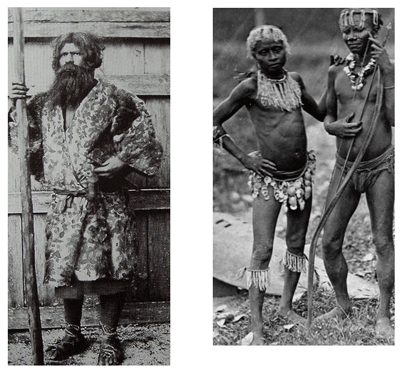|
Wednesday, December 23, 2009
 Just a weird random thought. In the early 20th century the Ainu of Japan were considered by many physical anthropologists a branch of the white race. This fit in nicely with the historical fantasy of the period which often featured "Lost Races," with a lost white race the best of all. By contrast, the Negrito and Melanesian populations were considered outliers of the black race. Though the idea of Ainu as white seems to have diminished, in part because those sorts of ideas aren't too popular today, and partly because hardly any Ainu remain who do not have substantial ancestry from the Japanese. On the other hand, there remain pan-Africanists and black nationalists who talk about the unity of black peoples, from India to Melanesia. To the left is a photo where I've placed an Ainu man from the 19th century next to contemporary Andaman Islanders. I think you could understand why physical anthropologists of the period classified populations as they did based on appearance. Just a weird random thought. In the early 20th century the Ainu of Japan were considered by many physical anthropologists a branch of the white race. This fit in nicely with the historical fantasy of the period which often featured "Lost Races," with a lost white race the best of all. By contrast, the Negrito and Melanesian populations were considered outliers of the black race. Though the idea of Ainu as white seems to have diminished, in part because those sorts of ideas aren't too popular today, and partly because hardly any Ainu remain who do not have substantial ancestry from the Japanese. On the other hand, there remain pan-Africanists and black nationalists who talk about the unity of black peoples, from India to Melanesia. To the left is a photo where I've placed an Ainu man from the 19th century next to contemporary Andaman Islanders. I think you could understand why physical anthropologists of the period classified populations as they did based on appearance.But with all the more recent genetic studies it seems pretty clear that the Ainu and the Andaman Islanders are part of a broader swath of "easterners" who swept out of Africa (in fact, there are Y chromosomal haplogroups which the Ainu share with Andaman Islanders). Older classical markers suggested that the Ainu were an East Asian people, and the uniparental markers suggest the same thing (I don't see any more recent SNP array studies which look at the Ainu). As for the Andaman Islanders, it seems very likely that they're simply an island population of the ancient "eastern" substrate of South Asia, which has been admixed on the mainland with a "western" quasi-European element, which in many regions and castes is now dominant. The Ainu and the Andaman Islanders are probably just the remains of the physical diversity which was once much more common in eastern Eurasia than it is today. That diversity may have gone by the wayside because of the expansion of the Han and the Austronesians, but it may serve as a hint that there may be only a few basic human racial morphs which reoccur, whether by chance or adaptation. Addendum: The non-Bantu populations of southern Africa look East Asian. Also, since the Reich et al. paper on Indian genetics came out I've been reading up, and now I can see how the Andaman Islanders do kind of "look Indian." More specifically, there are some subtle facial features which South Asians have which must have come down from people distantly related to the Andaman Islanders. Look at the individual on the left in the photo above. Labels: Genetics |



